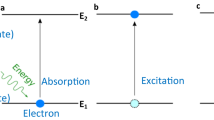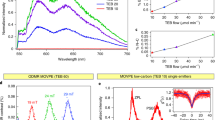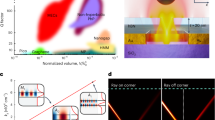Abstract
The demand for compact ultraviolet laser devices is increasing, as they are essential in applications such as optical storage, photocatalysis, sterilization, ophthalmic surgery and nanosurgery. Many researchers are devoting considerable effort to finding materials with larger bandgaps than that of GaN. Here we show that hexagonal boron nitride (hBN) is a promising material for such laser devices because it has a direct bandgap in the ultraviolet region. We obtained a pure hBN single crystal under high-pressure and high-temperature conditions, which shows a dominant luminescence peak and a series of s-like exciton absorption bands around 215 nm, proving it to be a direct-bandgap material. Evidence for room-temperature ultraviolet lasing at 215 nm by accelerated electron excitation is provided by the enhancement and narrowing of the longitudinal mode, threshold behaviour of the excitation current dependence of the emission intensity, and a far-field pattern of the transverse mode.
This is a preview of subscription content, access via your institution
Access options
Subscribe to this journal
Receive 12 print issues and online access
$259.00 per year
only $21.58 per issue
Buy this article
- Purchase on Springer Link
- Instant access to full article PDF
Prices may be subject to local taxes which are calculated during checkout







Similar content being viewed by others
References
Nakamura, S. et al. InGaN-based multi-quantum-well-structure laser diodes. Jpn J. Appl. Phys. Lett. 35, L74–L76 (1996).
Nakamura, S. et al. InGaN/GaN/AlGaN-based laser diodes with modulation-doped strained-layer superlattices grown on an epitaxially laterally overgrown GaN substrate. Appl. Phys. Lett. 72, 211–213 (1998).
Boguslawski, P. & Bernholc, J. Doping properties of C, Si, and Ge impurities in GaN and AlN. Phys. Rev. B 56, 9496–9505 (1997).
Onuma, T. et al. Exciton spectra of an AlN epitaxial film on (0001) sapphire substrate grown by low-pressure metalorganic vapor phase epitaxy. Appl. Phys. Lett. 81, 652–654 (2002).
Zupan, J. & Kolar, D. Optical properties of graphite and boron nitride. J. Phys. C 5, 3097–3100 (1972).
Brown, F.C., Bachrach, R.Z. & Skibowski, M. Effect of X-ray polarization at boron K edge in hexagonal BN. Phys. Rev. B 13, 2633–2635 (1976).
Zunger, A., Katzir, A. & Halperin, A. Optical properties of hexagonal boron nitride. Phys. Rev. B 13, 5560–5573 (1976).
Tegeler, E., Kosuch, N., Wiech, G. & Faessler, A. Electronic structure of hexagonal boron nitride. Phys. Status Solidi B 91, 223–231 (1979).
Davies, B.M., Bassani, F., Brown, F.C. & Olson, C.G. Core excitons at the boron K edge in hexagonal BN. Phys. Rev. B 24, 3537–3546 (1981).
Carpenter, L.G. & Kirby, P.J. The electrical resistivity of boron nitride over the temperature range 700 °C to 1400°C. J. Phys. D 15, 1143–1151 (1982).
Sugino, T., Tanioka, K., Kawasaki, S. & Shirafuji, J. Characterization and field emission of sulfur-doped boron nitride synthesized by plasma-assisted chemical vapor deposition. Jpn J. Appl. Phys. 36, L463–L466 (1997).
Hoffman, D.M., Doll, G.L. & Eklund, P.C. Optical properties of pyrolytic boron nitride in the energy range 0.05–10eV. Phys. Rev. B 30, 6051–6056 (1984).
Tarrio, C. & Schnatterly, S.E. Interband transitions, plasmons, and dispersion in hexagonal boron nitride. Phys. Rev. B 40, 7852–7859 (1989).
Lopatin, V.V. & Konusov, F.V. Energetic states in the boron nitride band-gap. J. Phys. Chem. Solids 53, 847–854 (1992).
Taylor, C.A. et al. Observation of near band gap luminescence from boron nitride films. Appl. Phys. Lett. 65, 1251–1253 (1994).
Jia, J.J. et al. Resonant inelastic X-ray scattering in hexagonal boron nitride observed by soft-X-ray fluorescence spectroscopy. Phys. Rev. Lett. 76, 4054–4057 (1996).
Carlisle, J.A. et al. Band structure and core hole effects in resonant inelastic soft-X-ray scattering: Experiment and theory. Phys. Rev. B 59, 7433–7445 (1999).
Solozhenko, V.L., Lazarenko, A.G., Petitet, J.P. & Kanaev, A.V. Bandgap energy of graphite-like hexagonal boron nitride. J. Phys. Chem. Solids 62, 1331–1334 (2001).
Robertson, J. Electronic structure and core exciton of hexagonal boron nitride. Phys. Rev. B 29, 2131–2137 (1984).
Catellani, A., Posternak, M., Baldereschi, A. & Freeman, A.J. Bulk and surface electronic structure of hexagonal boron nitride. Phys. Rev. B 36, 6105–6111 (1987).
Park, K.T., Terakura, K. & Hamada, N. Band structure calculations for boron nitrides with 3 different crystal structures. J. Phys. C 20, 1241–1251 (1987).
Xu, Y.N. & Ching, W.Y. Calculation of ground state and optical properties of boron nitrides in the hexagonal, cubic, and wurtzite structures. Phys. Rev. B 44, 7787–7798 (1991).
Furthmuller, J., Hafner, J. & Kresse, G. Ab-initio calculation of the structural and electronic properties of carbon and boron nitride using ultrasoft pseudopotentials. Phys. Rev. B 50, 15606–15622 (1994).
Liu, L., Feng, Y.P. & Shen, Z.X. Structural and electronic properties of h-BN. Phys. Rev. B 68, 104102 (2003).
Taniguchi, T. & Yamaoka, S. Spontaneous nucleation of cubic boron nitride single crystal by temperature gradient method under high pressure. J. Cryst. Growth 222, 549–557 (2001).
Kawarada, H. et al. Excitonic recombination radiation in undoped and boron-doped CVD diamonds. Phys. Rev. B 47, 3633–3637 (1993).
Kawarada, H. & Yamaguchi, A. Excitonic recombination radiation as characterization of diamonds using cathodoluminescence. Diamond Relat. Mater. 2, 100–105 (1993).
Kawarada, H., Tsutsumi, T., Hirayama, H. & Yamaguchi, A. Dominant free-exciton recombination radiation in CVD diamonds. Appl. Phys. Lett. 64, 451–453 (1994).
Knox, R.S. Theory of Excitons (eds Seitz, F. & Turnbull, D.) (Academic, New York, 1963).
Koster, G.F. in Solid State Physics (eds Seitz, F. & Turnbull, D.) 173 (Academic, New York, 1957).
Mishima, O. & Era, K. in Electric Refractory Materials (ed. Kumashiro, Y.) 495–556 (Marcel Dekker, New York, 2000).
Shinada, M. & Sugano, S. Interband optical transitions in extremely anisotropic semiconductors. 1. Bound and unbound exciton absorption. J. Phys. Soc. Jpn 21, 1936–1946 (1966).
Dean, P.J., Lightowlers, E.C. & Wight, D.R. Intrinsic and extrinsic recombination radiation from natural and synthetic aluminum-doped diamond. Phys. Rev. 140, A352–A368 (1965).
Teofilov, N. et al. Optical high excitation of diamond: phase diagram of excitons, electron–hole liquid and electron-hole plasma. Diamond Relat. Mater. 12, 636–641 (2003).
Masumoto, Y., Unuma, Y., Tanaka, Y. & Shionoya, S. Picosecond time of flight measurements of excitonic polariton in CuCl. J. Phys. Soc. Jpn 47, 1844–1849 (1979).
Reynolds, D.C., Look, D.C. & Jogai, B. Optically pumped ultraviolet lasing from ZnO. Solid State Commun. 99, 873–875 (1996).
Ding, J. et al. Excitonic gain and laser-emission in Znse-based quantum-wells. Phys. Rev. Lett. 69, 1707–1710 (1992).
Zaitsev, A.M. Optical Properties of Diamond (Springer, New York, 2001).
Acknowledgements
We thank S. Koizumi and M. Katagiri for technical support in the lasing experiments, and T. Kuroda and K. Kobayashi for useful suggestions on the band structure of hBN.
Author information
Authors and Affiliations
Corresponding author
Ethics declarations
Competing interests
The authors declare no competing financial interests.
Rights and permissions
About this article
Cite this article
Watanabe, K., Taniguchi, T. & Kanda, H. Direct-bandgap properties and evidence for ultraviolet lasing of hexagonal boron nitride single crystal. Nature Mater 3, 404–409 (2004). https://doi.org/10.1038/nmat1134
Received:
Accepted:
Published:
Issue Date:
DOI: https://doi.org/10.1038/nmat1134
This article is cited by
-
Flexible thermoelectrics in crossed graphene/hBN composites
Scientific Reports (2024)
-
Cathodoluminescence spectroscopy of monolayer hexagonal boron nitride
Scientific Reports (2024)
-
Novel PANI:Borophene/Si Schottky device for the sensitive detection of illumination and NaCl salt solutions
Journal of Materials Science: Materials in Electronics (2024)
-
Confocal nonlinear optical imaging on hexagonal boron nitride nanosheets
PhotoniX (2023)
-
Optimizing thermoelectric performance of carbon-doped h-BN monolayers through tuning carrier concentrations and magnetic field
Scientific Reports (2023)



